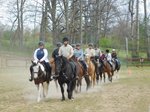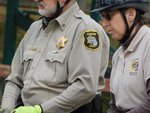 Harrison, MI
Harrison, MIFair, 26°
Wind: 0.0 mph, N
 Harrison, MI
Harrison, MI





HARRISON – No one who ever spent any time with the Clare County Sheriff Department Mounted Division could miss one basic fact: this group is comprised of dedicated, capable, selfless and focused individuals. What is all too often missed, however, is the fact that every one of its members is an unpaid volunteer who provides his or her own mount and foots the bill for all expenses. And while there are occasional donations from appreciative individuals, there is no reimbursement for maintaining their horses, travel or for their time.
Yet, these riders train regularly to ensure their mounts are able to handle a wide variety of obstacles in diverse terrain, all with the goal of being ready at a moment’s notice to assist in finding a missing child or an adult who may have wandered away from caregivers. Sometimes the task is to assist in locating a fugitive. At other times it may be to function as an arm of law enforcement, providing crowd control assistance at large events such as the Irish Festival, car shows, county fair, and more.
The group’s most recent training was the Michigan Mounted Police Tactical Horsemanship Academy, held the weekend of May 14-16 at the Clare County Fairground. While trainings often focus on search and rescue, and conditioning horses to calmly manage unusual obstacles and conditions they might encounter on the job, this training was geared more toward hands-on work and crowd control
Thus, featured topics were “Basic Control and Horse Management” and “Full Hands-on Mounted Police Work,” and riders from Saginaw, Lenawee, Mecosta and other areas of the state attended. They sought to increase their own knowledge and skills, as well as increase their horses’ ability to handle interacting with individuals and possibly unruly, noisy crowds.
“It’s tactical horsemanship for the police horse – basically, how to get your horse to be a police horse,” said Capt. Jesse Loudenslager, Mounted Division commander. “We’re not having the obstacles this year, because quite frankly, you need to have your horse past the obstacle part by the time you get to what we want to teach.
“We want to lean more toward the police work end – not getting your horse to that point,” he said. “It’s a little different program than what we’ve done before – a little more advanced end of it is what we’re looking at.”
Of course, COVID-19 affected this year’s turnout, with 20 registrants dwindling down to about a dozen. Yet, with a smaller group, that meant more time could be spent per individual.
“That’s what we said,” Loudenslager said. “Our groups would be smaller and there’s more opportunity for hands-on.”
And that’s how it turned out to be when training began Saturday morning. Twelve participants quickly became 10, and after some basic work, they were divided into two groups. The first group, instructed by Loudenslager, focused on horse and crowd management. The other, instructed by Erik Little, a police officer with the City of Big Rapids, focused on hands-on mounted work, i.e. suspect apprehension. One small element of that was two riders working in concert to position their horses such that the suspect could not flee by passing between them.
The crowd control group had to first learn the basics of how to function as a synchronized professional unit, guided by a designated leader who called out commands that directed motion, direction and flow. One key element was the need to keep the group of horses moving in a single direction while simultaneously maintaining a parallel-yet-staggered position. This movement allows a group of riders to create a “sweeping” motion, as would be needed when pushing people back from a roadway.
After the basics, came practical application training: that meant members of the Mounted Division turning themselves into a surly group of protesters/demonstrators who were all about yelling, threatening, and standing their ground as they swung around foam pool noodles, rattly plastic bags on sticks, and flags.
It was a test of rider observation and control, and of the horses’ ability to tune out distractions.
Dean Boivin of the Saginaw County Sheriff Posse was riding a mild-mannered black horse that Loudenslager told the other riders was exactly the horse they each should want their horse to become.
“He just don’t care,” Loudenslager said. “Nothing here is bothering him.”
He went on to explain that the horse was focused only on his rider and waiting to do whatever was asked of him.
Next came the patrol car with lights flashing, where the exercise was to sweep people away from the outside of the car, flank and protect it, enabling it to proceed on its way (without denting the car). Again, staggering riders allowed for “sweeping” people away from the vehicle.
Another important piece of the training addressed the close quarters of being in a crowd, the limited space in which a rider can reverse his horse’s direction, and different types of turns for different situations.
Well-trained animals have long provided steady and dependable support for law enforcement – and that goes beyond horses. Providing an enhancement to the weekend’s tactical horse and rider education, Saturday’s sessions were scheduled to close out with an evening presentation by Deputy Larry Kahsin of the Clare County Sheriff Department K-9 Unit.
The next time attendees notice mounted officers onsite at any of the county’s various large-crowd events, they might keep in mind the countless hours of training and commitment that enable each of these officers to serve their fellow citizens. But don’t rush up to pet the horse – he’s working.
Comments
No comments on this item Please log in to comment by clicking here